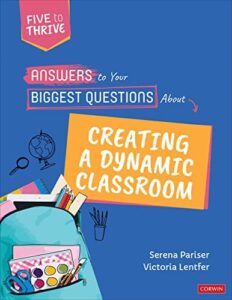How Can We Create a Dynamic Classroom?
Answers to Your Biggest Questions About Creating a Dynamic Classroom
By Serena Pariser and Victoria Lentfer
(Corwin, Five to Thrive Series, 2022 – Learn more)
Reviewed by Kathleen Palmieri

In their book, Answers to Your Biggest Questions About Creating a Dynamic Classroom, Pariser and Lentfer answer five main questions and include practical ways to build routines, minimize off-task behaviors, and plan lessons that incorporate technology while also offering differentiation.
The five main questions (and chapter titles) are:
- How do I build an affirming classroom community?
- How do I keep students at the center?
- How can I design effective, fun, and engaging learning for students?
- How can I make assessments work for me and my students?
- What are the things I need to know but are rarely discussed in a teacher training program?

Student centered space for learning
Starting with question one, the focus is on classroom community. The sub questions prompt us to consider building effective seating charts and routines, suggest ways to keep and reflect a growth mindset, and much more.
Pariser and Lentfer also offer realistic ways to make the classroom visually appealing as well as functional, noting “students simply function at a higher level in a visually organized classroom.” (p. 11)
Chapter 2 is focused on keeping students at the center, offering the definition of what student-centered actually means: students taking on leadership roles and decision making, along with having a voice in the day-to-day classroom routine. Building relationships, connecting with challenging students, providing support to students who are falling behind, and allowing student voice in creating behavior expectations are all discussed.
Pariser and Lentfer suggest that we “Allow student voice in creating behavior expectations so students feel a sense of ownership of classroom expectations and can support one another in following them.” (p. 55)
Lessons and assessments that work
Chapter 3 helps us consider how we can design effective, fun, and engaging learning for students. This chapter is the focus area of “instruction” and offers answers to sub questions such as what students really want in a lesson and how to make lessons “relevant, rigorous, and fun all at the same time.”
Pariser and Lentfer believe that “Designing effective, fun, and engaging lessons, simply put, is our job. This comes with practice, patience, creativity, and collaboration.” (p. 59)
Chapter 4 focuses on the question “How can I make assessments work for me and my students?” and offers answers to questions such as how to find engaging ways to check for understanding, what effective feedback looks like, and what to do with assessment data.
The answer to the question “When and why should I use Rubrics?” offers an insightful look at not only using rubrics to grade an assignment, but notes “they are also used during the creation process of the assignment.” Pariser and Lentfer further state, “This way the student knows exactly what is expected of them.” (p. 89)
The world beyond teacher training programs
Chapter 5 is focused on “agency” and addresses the main question, “What are the things I need to know, but are rarely discussed in a teacher training program?” The sub questions include “How do I keep a work life balance?”, “How do I navigate a difficult meeting with a parent or caregiver?”, and “What are some effective time-saving hacks?” to name just a few. (p.105)
In regard to the work/life balance, Pariser and Lentfer state, “Work/life balance means maintaining your social relationships and activities outside of work. And it means being proactive to enjoy a personal life, as difficult as that may seem the first few years. Maintaining a work/life balance requires you to pay attention to signals that the balance is off, too.” (p. 106)
This chapter also offers advice on areas that we often don’t learn in our teacher preparation programs – such as dealing with difficult parents. Pariser and Lentfer share ways to communicate with parents and caregivers as well as ways to build a supportive relationship with administrators. These are two key areas that every educator could benefit from.
Going deeper with add-ons and sidebars
Each chapter offers practical sub questions, tips, and sidebars offering quick “Keep in Mind” or “Agency and Identity” advice, or a “Great Resource” such as a blog post, chart, or book title. Informative QR codes are found throughout the book.
Chapter 3, for example, points to a video titled “Does Engagement Equal Fun” from Just Ask Us (Wolpert-Gawron, 2018) (p. 60) and in chapter 4, an Edutopia video (2021) “shows how differentiation can help the teacher meet the wide variety of student levels.” (p. 95) Finally, each question has an “Ask Yourself” section that provides a question to apply to your own teaching practice.
This book is part of the Corwin “Five to Thrive” series, where each book “provides new teachers with just-in-time, research-backed, classroom-tested advice from experts who have decades of teaching experience. Friendly, accessible, and practical, each book in the series details the five most important things new teachers need to know to put theory into practice” (Corwin).
For newbies and vets alike
Pariser and Lentfer’s book offers answers and great practical strategies, thoughts, and resources for all educators. Whether you are a first year teacher or entering your 20th year of teaching, Answers to Your Biggest Questions About Creating a Dynamic Classroom has a lot to offer and is a great resource to share with colleagues, old and new.
Kathleen Palmieri is a National Board Certified Teacher and NBCT Professional Learning facilitator. She is a fifth grade educator in upstate New York who reviews and writes regularly for MiddleWeb. With a passion for literacy and learning in the classroom, she participates in various writing workshops, curriculum writing endeavors, and math presentations. As a lifelong learner, she is an avid reader and researcher of educational practices and techniques. Collaborating with colleagues and globally on X-Twitter and expanding her education adventures at www.kathleenpalmieri.com are ongoing practices.


































